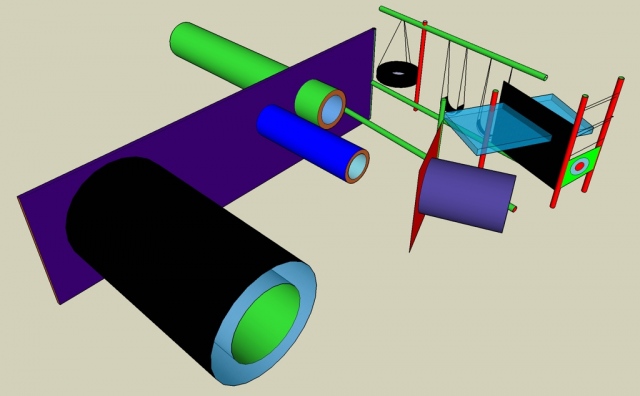Grounds for Play
GROUNDS FOR PLAY
Project Description:
By using sustainable playground technology and reusing otherwise wasted or excess materials from industry or other sources particular to each chosen location in the developing or developed world, I will facilitate the building of playgrounds that promote environmental consciousness and resourcefulness and sustainable social and community development.
This project was developed by realizing the importance of play and the positive sustainable effects it can have on communities within our society. These playgrounds will be community driven efforts, addressing basic and social needs (i.e. water, sanitation, community issues) unique to each location.
Audience/Venue:
Each location for this project will be chosen by three factors: An industry or other source producing excess materials, a specific need and want from the community for a renewable resource or community development project of this type, and a willingness and ability to sustain this project from within the community. Because each playground will be different according to the above factors and its location, the audience will change for each project.
Experimental Approach:
This project is experimental in many ways. Because each project will be different, each playground will require experimental building techniques that pertain to each material, location and its people. Identifying the basic and social needs of the community and realizing whether a playground can address any of these specific needs is an important first step. For example, if a community needs a water source, playground technology (teeter-totters and merry-go-rounds) can serve as water pumps. The teamwork that will be required to build a playground will truly be a community-building experience but the challenge will be how to sustain the relationships realized through the experience of building. An experimental, innovative approach will be needed to assess and overcome these fundamental challenges.
Materials:
Materials will be unique to each playground depending on its location and what discarded materials can be reused. This will involve initial research and assessment of resources in each community.
Ideas:
Doors of laundry machines for windows to look through and open, possibly crawl through
Rubber from discarded tires used for swings of all types.
Pipes could be used as structure as well as kaleidoscopes
Waste/sewage could go into tubes to fertilize soil and make a garden grow at other end
Envisioned Playground Components:
Slides
Swings
Bridges
Ladders, climbable places
Fire-poles
Interactive Toys (tractors, etc.)
Merry-go-round (can serve as water pump)
Teeter Totter (can serve as water pump)
Fort or other small environment
Kaleidoscopes (small and large)
Resources:
Financial resources by way of grants and fellowships will be key to making this project happen.
Other than financial resources, finding a team of community facilitators, researchers, designers and builders will be needed as well as and finding materials in the locations where each playground will be built.
Organizations of Influence/ Inspiration:
Architreasures www.architreasures.org
PlayPumps International www.playpumps.org
Rural Studio
Kenya Youth Sponsorship Program
Global Routes www.globalroutes.org
Engineers Without Borders www.ewb-usa.org
Worldchanging www.worldchanging.com
Kaboom Playground builders www.kaboom.org
Progressive Design Playgrounds www.pdplay.com
Context:
This project is directly related to my past experience as an artist and a community worker. Through my art I have built environments with a focus on play and childhood and have more recently been focused on creative reuse, working with the potential of spaces, objects or materials that are otherwise deemed to be useless. As a community worker, I have been involved in various community projects within the U.S. and the developing world.
This project crosses the realms of community building, green design, creative reuse and recycled art and design, art or community work with ecological and environmental awareness, and global engineering.
Design:
The design would be unique for each playground depending upon its variables. Structure, safety, and accessibility would all be taken into account.
Design #1: Water
More than one billion people worldwide do not have access to clean water. In many developing countries women and children walk many miles carrying water to their homes, losing valuable time to study, work or play. Water-related diseases are the leading cause of death in the world, taking the lives of 6,000 people a day, and are responsible for 80 percent of all sickness in the world.
The focus of this design is to provide clean water for the community in closer proximity to its population. It would be built in the central location of a community, possibly at a school. Merry-go-round water pumping technology would be the central point of this playground and other elements would be built around this. This playground would not only serve as the main water source for community members, it would also be a community and social gathering place.
PlayPumps International has been successfully using their merry-go-round water pumps in much of South Africa for the past few years. This technology or something similar would be used in the playground designs.
Design #2: Water/Agriculture
This playground would be built in the central location of a community, possibly at a school. Merry-go-round water pumping technology would be the central point of this playground and other elements would be built around this. A community garden would be built adjacent to the playground and the water pumped from the ground could be used to water this garden. Children could play on the playground while their parents or babysitters worked in the garden. Workshops about agriculture and water could be held here as well.
Design #3: Solar/Wind Energy
This design would also be built in the central location of a community, possibly at a school or park. Swings would be the central point of this playground and other elements would be built around this. The energy from the pendulum motion of swinging would be collected and used for electricity or another source of energy. This design could be used in the developing or developed world. Solar panels would also be installed in various parts of the playground, creating a second source of energy.
